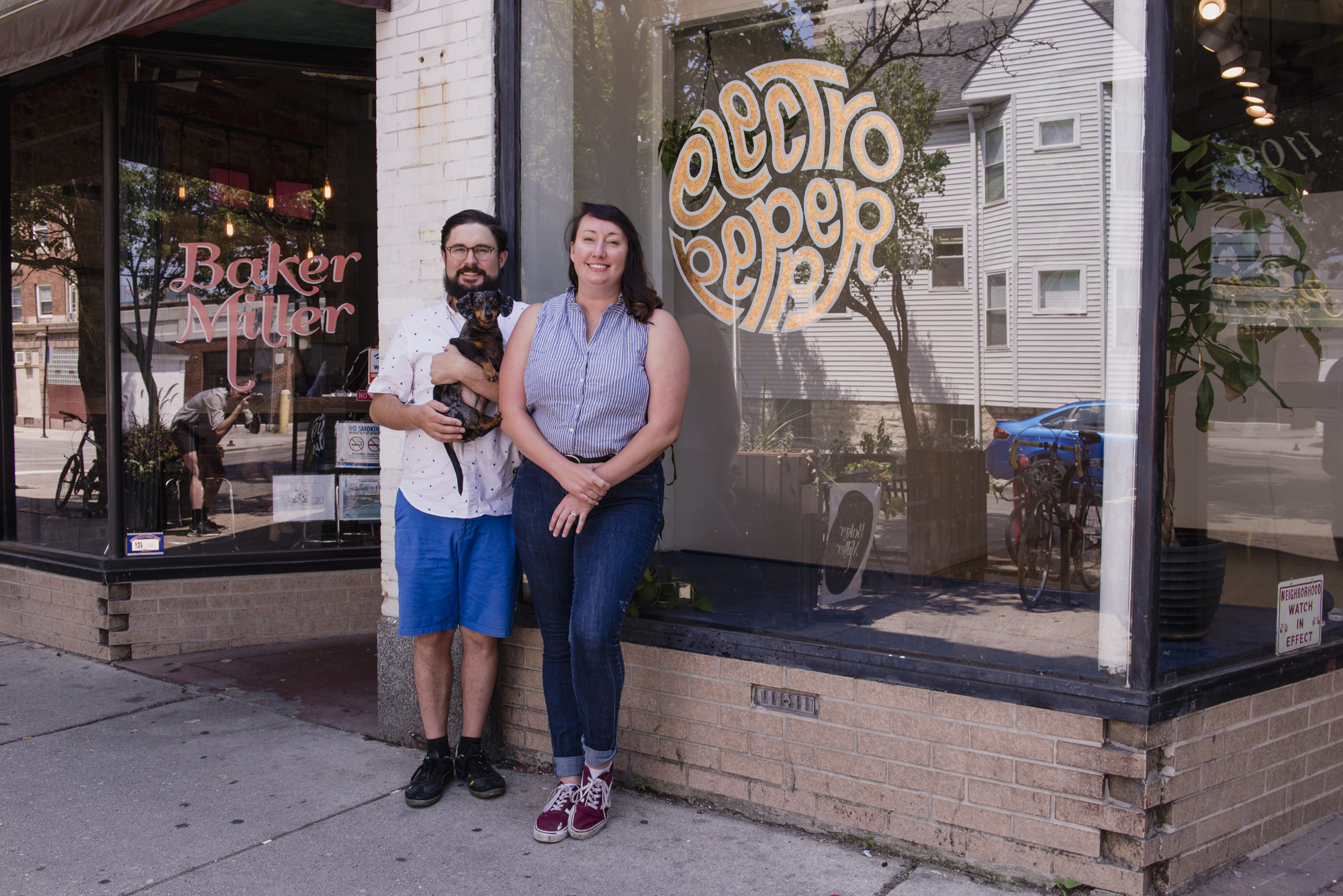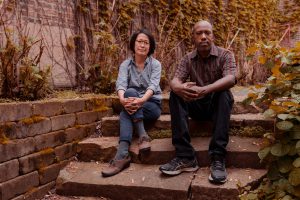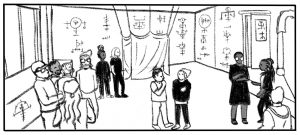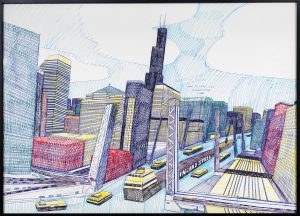Kelsey Dalton McClellan and Andrew James Welch McClellan have owned and operated Heart & Bone, Gold Gilded and Hand Painted Signs for the past six years, specializing in gold leaf and hand-painted signs throughout Chicago and nation-wide. The duo has now expanded their repertoire as they open their new gallery, Electro Pepper, in the Uptown neighborhood. Their aim is to use this endeavor as a flexible space to promote learned trades and labor-based artworks. Sixty Inches from Center sat down with Kelsey and Andrew to learn more about their path as sign painters, artists, and now, gallery owners.
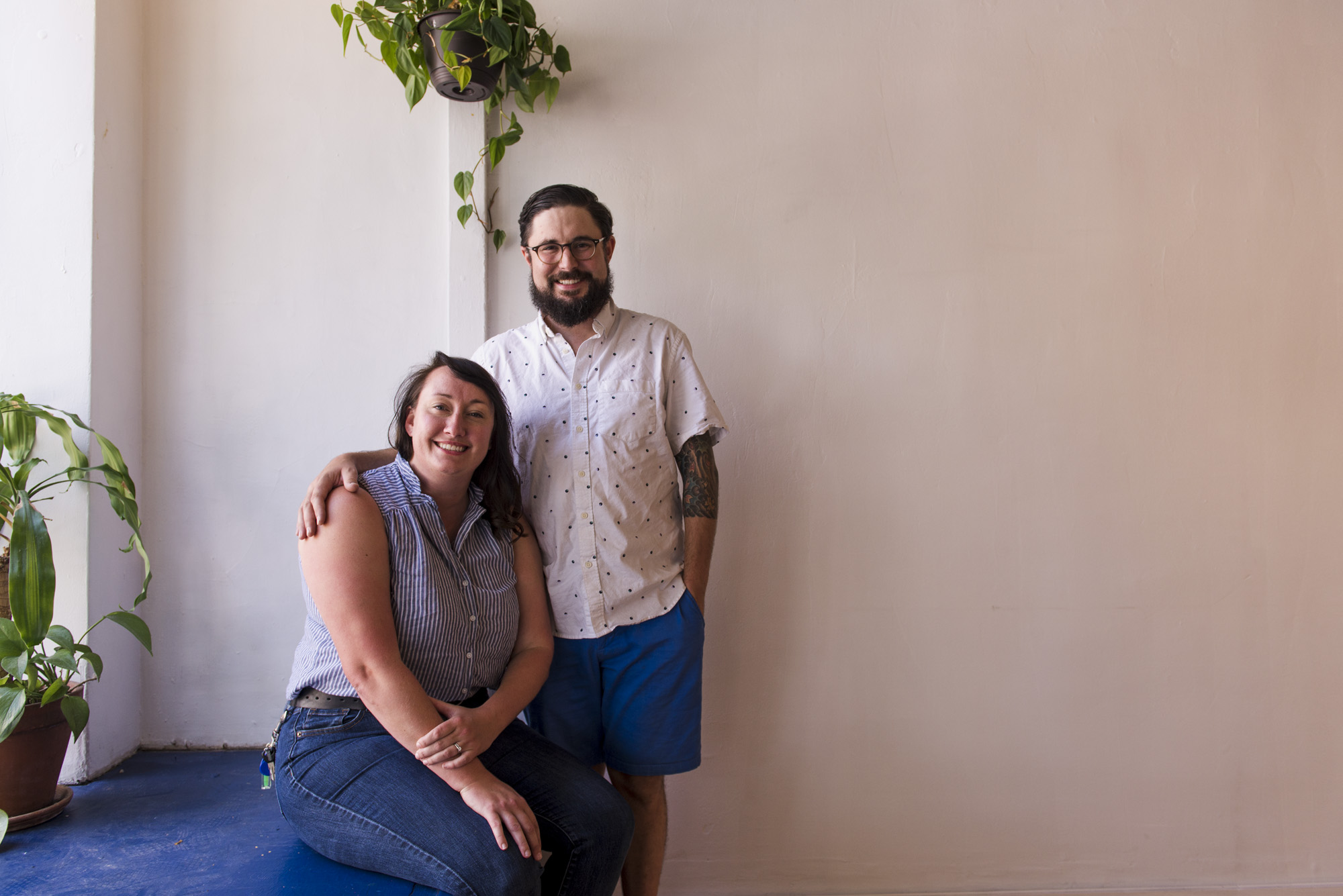
Emily Breidenbach: We’re sitting in your new gallery space, Electro Pepper. What can you tell me about it?
Kelsey Dalton McClellan: The space we are in is multi-use. The front is a flexible gallery space and the back is our sign painting studio. Eventually, we’d like to have workshops and other events outside of art openings. At the moment, we’re kind of testing it out and receiving community response through monthly art openings. The majority of the time, we’re working in the back in our workspace, so our open hours are by appointment only.
EB: How did you find this location?
KDM: We live about 10 minutes away—we first found it two years ago. There was a big “for rent” sign, and we were at a point in our business where we wanted more space. One day, we sort of impulsively said, “Let’s just call the number.” The landlord immediately answered and was like, “Yeah, come see it.” At that point, after seeing it, we were like, “Oh, this is awesome, how can we do this?” But I had just gone back to school, and it was bad timing. So we waited two years until I graduated, and then after some thought said, “All right, if it’s still available, let’s do it.” Luckily, it was still available and we moved in pretty quickly after that!
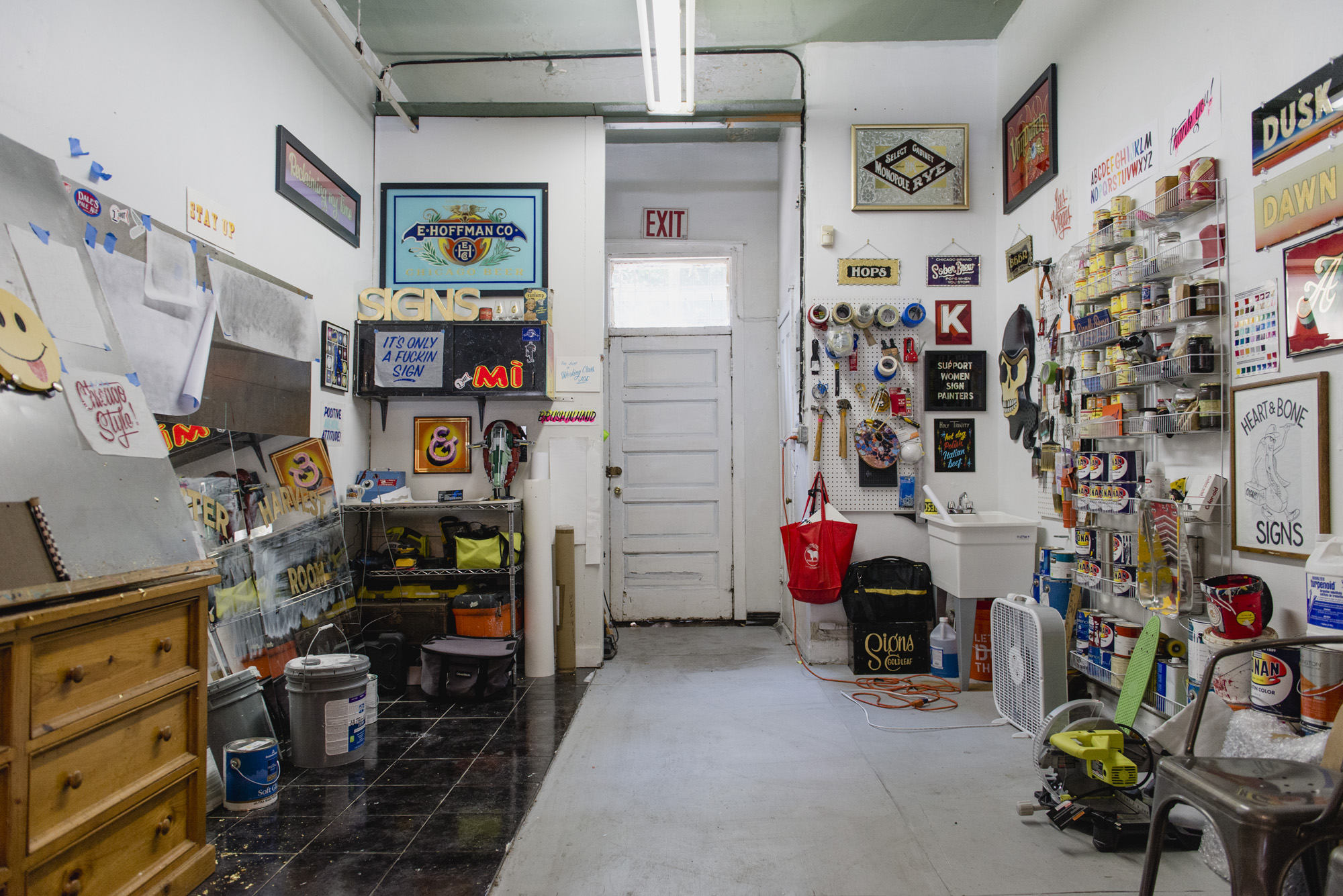
Andrew James Welch McClellan: The space had been empty for more than five years, and we realized after meeting the landlord, that he’s the type of guy who doesn’t care whether this place is rented or not. He wanted to have someone that he could trust, and somebody that he liked rather than just renting the space to any capable business owner. We found out that he used to rent—back in the day in the ’70s—to a sign painter in one of his other buildings. So he was kind of like, “Sign painters are no fuss! It’s not a big deal. You’re just doing your business in here. You’re painting stuff. Easy-peasy.” [Said in a heavy German accent.]
KDM: He actually knew what we do, which was really cool for us. He knew what we do and he had no objection to it, which was even better! It’s a cool structure. This building was built in 1903 and has a really interesting history that we are slowly piecing together. The façade is beautiful—it’s all ceramic tile. From personal accounts we’ve had with locals of the neighborhood, there were a lot of hardships in this area in the ‘80s. The landlord now was the same landlord then and I think he didn’t put a lot of money into the building, other than security bars, because he thought nothing was going to change in the area.
Now there are new things opening up. Steep Theater next door just opened up a bar and the coffee shop next door just changed ownership. The corner unit, which used to be a laundromat, needs a lot of work, but we agreed to start activating the space by putting art up in the windows and using it as an auxiliary gallery space. So we’ll start doing that next month and will be accepting proposals from artists interested in public installation—stay tuned!
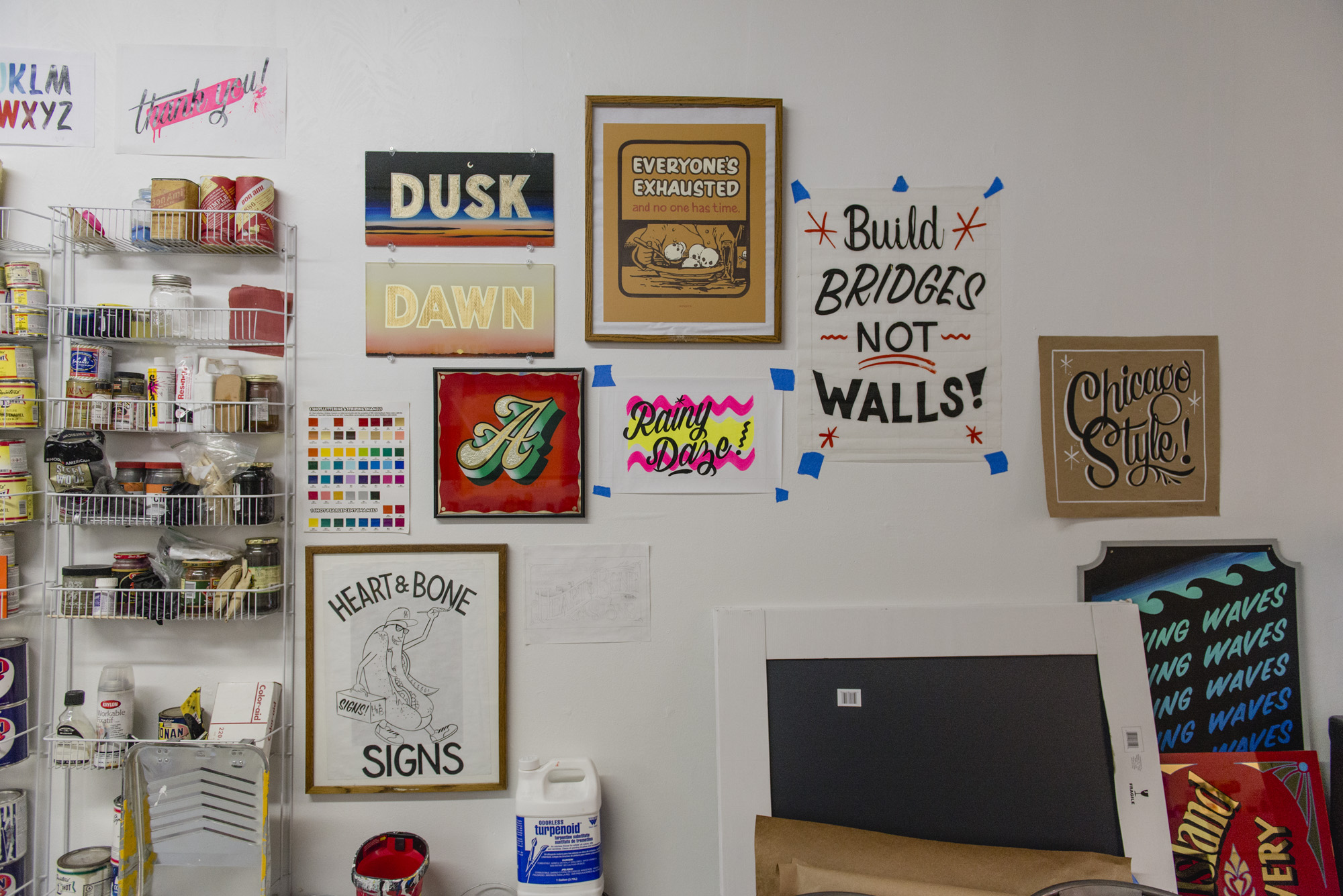
EB: What made you decide to open your own gallery?
KDM: About five years ago, we put together an art show of hand-painted signs in Chicago, and it had dawned on us that it might be something we wanted to do. Recently, we put together a show showcasing gold leaf and traditional beer signs, as they have a long-running history together, particularly in Chicago. We’re very involved in the gold leaf community here and across the United States, and we were trying to find a venue to show this group of work. Unfortunately, spaces in Chicago were just not understanding it—maybe they weren’t really interested in the type of work we were doing or it didn’t really fit in with their mission. After that experience, we realized we have the capability, experience, and education to do this—and most importantly, the community and support. Why don’t we just open up our own gallery and create the space that we felt we couldn’t find anywhere else?
EB: When did you start your sign-painting business and why?
AJWM: We started our sign-painting business in 2012. It wasn’t something that we necessarily did intentionally. Back in Denver, where we are originally from, we had both been painting signs without knowing exactly what we were doing. When we came out here, we had done some mural work and through that we had been contacted to do more commercial-type painting. Once we graduated from the painting program at the School of the Art Institute of Chicago, out of a mix of desperation, skill, and a new perspective on art and signage, we started our business.
KDM: Being in Chicago was an important part as well, mainly because the culture here values hand-painted signs. This is something we subconsciously picked up on and then quickly became obsessed with the amazing hand-painted signs everywhere. In Denver, the culture is different—we grew up around a lot of vinyl and other fast, cheap signs.
AJWM: A big part about being in Chicago was having the opportunity to meet up with Robert Frese, who runs Chicagold Signs. He is, ironically enough, the goldfather, of Chicago. He’s been gilding signs in Chicago since 1984. After meeting him, he really took us under his wing and became our mentor. We are really fortunate to have that kind of relationship with someone so experienced and skilled and who is so highly regarded in the field of gold leaf.
Moving into our current position was very fluid. We were both working full-time when we first started. Kelsey then went back to school though a tuition remission program while working full-time. I was also working full-time and it eventually got to the point where we were working like 90 hours a week! We were like, “This is insane! This can’t go on!” So, I took the jump and quit my job, and started doing sign painting full-time. Then, things continued to get busier and busier to the point where Kelsey quit her full-time job a couple of months ago, and now we are both doing this full-time. It’s pretty exciting, but it has been a long road and a labor of love.
KDM: But now we work 100 hours a week. [Andrew laughs]
AJWM: It’s an extraordinary amount of work.
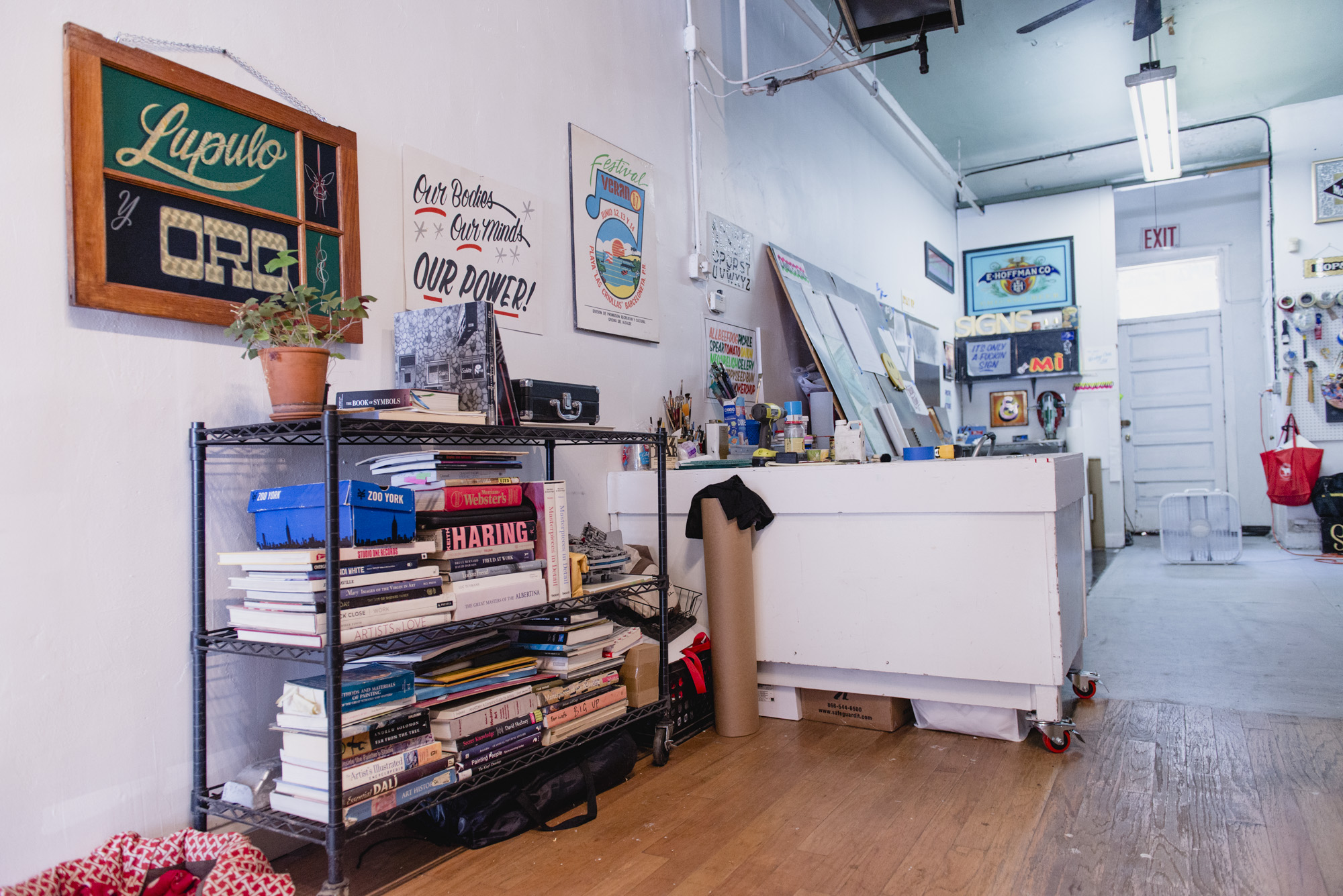
KDM: But it’s been really rewarding. Before, we both had been painting signs individually for coffee shops we worked for, among other restaurants. My first hanging sign was for a bike shop—but we worked just as artists. Once we realized that there was a trade out there of sign painters, that it was an actual profession, it just clicked. We became interested in sign painting and shortly thereafter, there was somewhat of a resurgence and renewed interest in sign painting in the community. So we kind of got lucky in that, at that point, people were actually really excited about sign painting and businesses were willing to invest in it. There was a movie that came out in 2013 called “Sign Painters: The Movie” and an accompanying book by Faythe Levine and Sam Macon. That movie helped to educate the market about the trade, the craft, and all of the work that goes into it. It also featured some amazing veteran sign painters who have been in the business for years. It’s been interesting to be involved in this resurgence and we now have this great community we are a part of. As we’ve developed our own practice and our business, we’ve grown with all these other people from around the world, so we are constantly learning and developing in correlation with our respected peers.
AJWM: It was just a circumstance of having perfect timing. As with so many things in life, it’s all about timing—meeting the right person, whatever it might be. We got into this thing and started taking it seriously right before the book came out! Then, once the book came out it was like, “Oh, there’s this whole other awareness about it.” And then, after that, the movie came out, and created a whole other awareness. Obviously folks who are like us, who are interested in typography, or are graphically-minded, or are maybe into graffiti—who have a mind to think about type and painting. They started getting into it. And so we were just ahead of that curve. Not very well ahead of it—really right before it happened.
KDM: Like, half a second ahead.
AJWM: Exactly. Which put us in a really cool place.
EB: Can you tell me about your first show and plans for future shows?
KDM: Our first show was in August and featured Kelly Golden, a talented woman, sign painter out of Detroit. I met her at the Pre-Vinylette show, a showcase of women sign painters from around the world that took place last year. We hit it off instantly and I had always admired her work, so we stayed in touch. She’s just insanely talented, so I knew she was someone I wanted to potentially reach out to. So when I asked her if she would be interested in a solo show and she was like, “Totally!” I kind of geeked out because I’m such a fan. She produces a lot of show cards—which were how advertisements were traditionally produced—of fictional scenarios based off pop culture, generally referencing a 70’s and 80’s aesthetic. What I like about the show cards is that they are completely fabricated advertisements, but they read as if they were intentional. She is also unique in that she went to an actual trade school for sign painting. So in terms of her technical approach, it’s very refined in the way someone making signs 30 years ago would approach the same subject.
AJWM: That trade school, the Los Angeles Trade-Tech College, is the sole remaining sign-painting school in the entire world, as far as I know. Doc Guthrie is the main instructor and has taught some incredible contemporary sign painters.
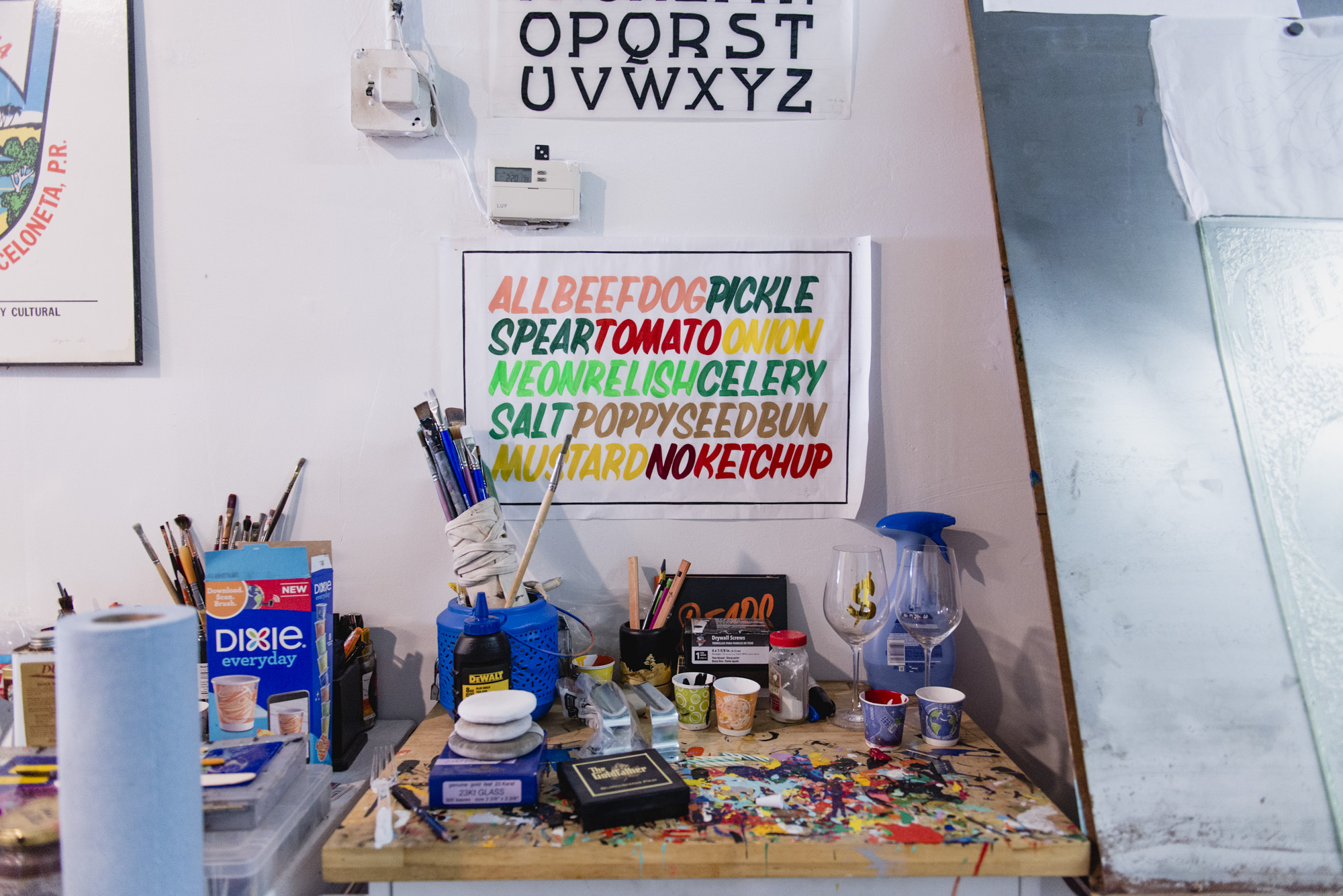
KDM: Our future exhibitions will focus on sign painting and other craft or labor-based art. We are working within a community that we are heavily involved with and we’re excited to show different forms of sign painting as well as other commercial, lettering and graphic art being produced in that field. The next exhibition is a group show of over 30 sign painters from around the country, opening September 8th. Overall, we like to think of the gallery as a flexible space so that we don’t tie ourselves down to one concept. We want to be able to grow as we experience the space and as the community gives their input on what they’re interested in seeing. We’re excited to see where it goes; there has already been a lot of interest.
AJWM: I think another way to look at it is, in Chicago and everywhere else—and I might be ignorant about this, but I’ll just go for it—there are two types of galleries in my mind. There’s the type of gallery that’s all about conceptual work, whatever it might be. You know, it’s abstract painting, it’s sculpture, etc. Then there’s the other type of gallery that is on the complete other side of the spectrum—though, perhaps not that different—and that is the graffiti art or street art gallery. They’re focusing on people who are doing that type of work. We’ve noticed there’s a void in between that. There’s a middle ground that no one is servicing! I think that is the type of work that we’re interested in celebrating and supporting, but we are continuing to try to define what that is.
EB: What’s the biggest challenge of owning your own business? What’s the best part?
KDM: I think—well, we’ve faced a lot of challenges recently—the hardest one is learning how to set your own schedule and to not have work constantly interfering with your life and wellbeing. Especially with social media and having the world connected to your phone, it seems like we’re constantly in that world and it’s hard to take a break and understand how to do that. You know, in a way we kind of made our hobby into our full-time job—we’ve made our hobby into our business. So now we kind of have to seek elsewhere for other hobbies in order to balance it. Sometimes it’s hard to seek that out, especially when you love what you do.
AJWM: I’m going to buy a kite on Amazon, and then we’ll fly kites.
KDM: We have done that!
EB: That’s an awesome hobby.
KDM: It was totally fun! Another challenge is growing as a business and to know how to do that successfully without overextending yourself.
AJWM: Yeah, we’re in a very challenging moment. A lot of things have changed—we’ve moved apartments, we moved our practice into this space, and we’ve taken quite a few big jumps. There have been some risks associated with that and it has been challenging. One thing I would like to say is that, without Kelsey, Heart & Bone Signs wouldn’t exist. It’s both of us, but I will say, she is truly the brains behind so much of what we’re doing. She’s the queen bee and I’m the worker bee. I don’t think I necessarily give her enough credit often enough, and perhaps this is a good moment to give her that credit, because it has been extraordinarily challenging. You know, when you come in here and think, “Oh, it’s so nice, you have a cool space, and you have all these things.” Well, it’s very hard. It’s taxing on our business, it’s taxing on our relationship—it’s difficult. And I want to take every chance I can to celebrate my amazing wife because, if it weren’t for her, none of this would be happening. These are things that really wouldn’t have come out of my mind.
KDM: I have crazy ideas and thank you for going along with them. [Laughs]
AJWM: I’m good at actualizing ideas, and she’s the idea person.
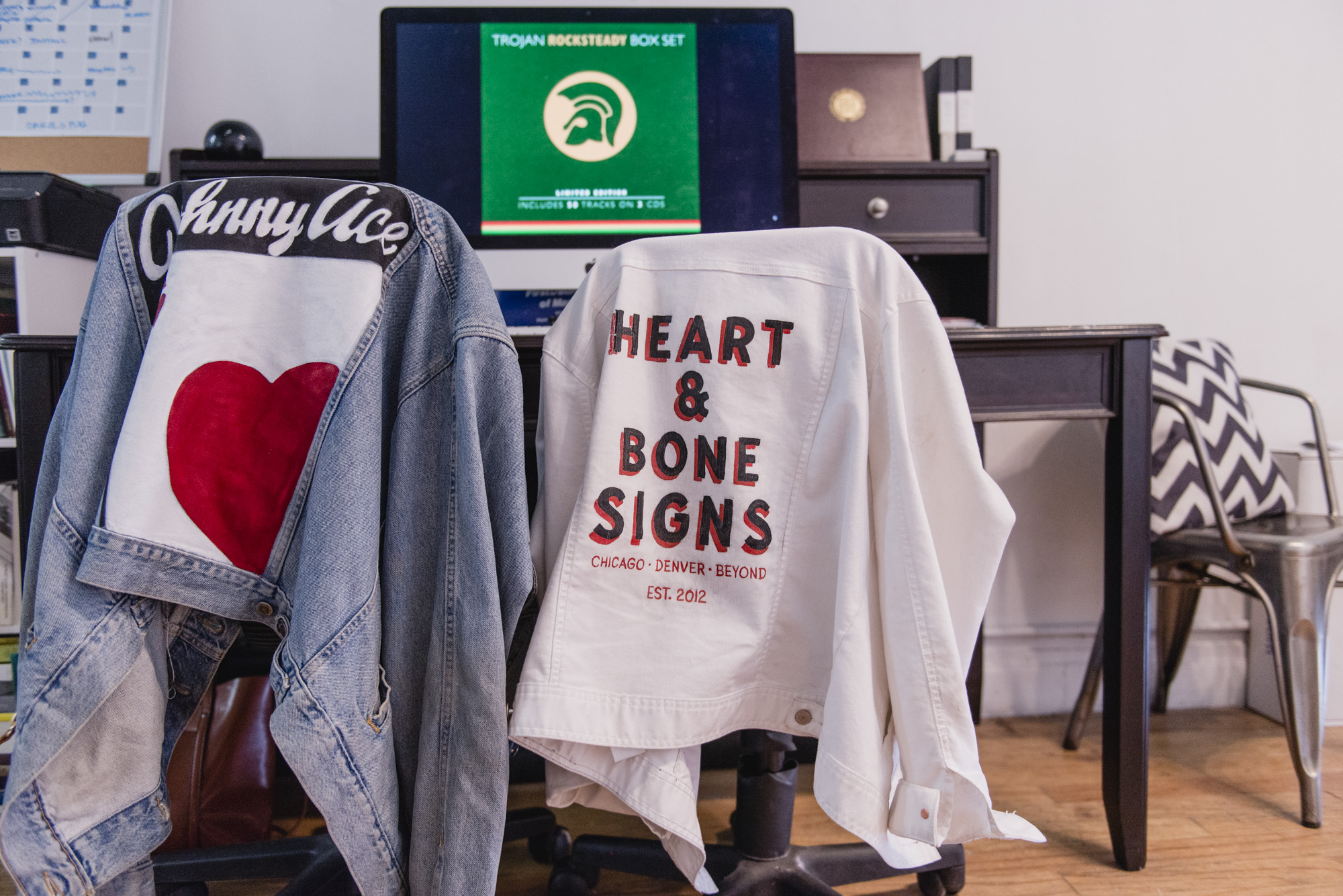
EB: What role do you think or hope your gallery will play in the larger arts landscape of Chicago? We kind of talked about it before—with the two ends of the spectrum, you’re trying to be in the middle.
KDM: Well, one thing I really like about this space is that we’re allowing people to have an insight into our practice. In doing so, we are sort of making it clear that we’re working as we’re showing artwork about labor and craft. I’m really interested in the idea of not just having a clean gallery space without any insight into what’s going on behind the scenes. I really like the idea of showing both sides of this, and there’s a whole other aspect of making, understanding the process of making, and what the space looks like when you are making. For instance, in school, being able to go to a gallery and talk to the director to see what they’re doing gave you an entirely different perspective. You’d think, “Oh, your desk is a mess and you don’t like this person and you chose to do this differently and this is how I feel about the art world.” You wouldn’t see that by just walking into the perfectly curated gallery on opening night. Not that that would be necessary in those spaces, but as makers showcasing makers, I feel it’s important to also show the messy and chaotic side of what we do.
It’s something we are trying to figure out as we go along, but as sign painters our work is always on display. For example, when we are working on-site in a window, people walking by often stop to observe our work and process. This type of labor performance has always intrigued me, so I’m interested in how the art we are displaying is interpreted in a space where that same art is being made.
EB: I totally agree. That is really unique here. Do you have any closing thoughts?
AJWM: We are looking forward to having shows here and we are working hard to get everything together to make that a reality. We are very excited to be here and even more excited to be a part of the community in Uptown/Edgewater, as it is a really special part of the city that has been good to us.
KDM: We also want to extend an invite to makers, movers, and shakers [laughs] who are interested in being a part of what we are doing or who needs a space to share what they do. So please reach out to us if you have an idea, we would love to hear from you!
EB: Thank you both!
Featured Image: Kelsey Dalton McClellan and Andrew James Welch McClellan, owners of Heart & Bone, Gold Gilded and Hand Painted Signs, outside of their new gallery space, Electro Pepper. Photo by Ryan Edmund Theil.
 Emily Breidenbach is an arts administrator with experience working at museums, education centers, and non-profits. She is currently the Assistant Director of Marketing and Enrollment for Continuing Studies at the School of the Art Institute of Chicago (SAIC) and has previously managed strategic communications for the Krannert Art Museum, the Frank Lloyd Wright Foundation, and the Museum Education department at the Art Institute of Chicago. She has a B.F.A. in Art History from the University of Illinois at Urbana-Champaign and is currently pursuing a M.A. in Arts Administration and Policy at SAIC.
Emily Breidenbach is an arts administrator with experience working at museums, education centers, and non-profits. She is currently the Assistant Director of Marketing and Enrollment for Continuing Studies at the School of the Art Institute of Chicago (SAIC) and has previously managed strategic communications for the Krannert Art Museum, the Frank Lloyd Wright Foundation, and the Museum Education department at the Art Institute of Chicago. She has a B.F.A. in Art History from the University of Illinois at Urbana-Champaign and is currently pursuing a M.A. in Arts Administration and Policy at SAIC.
